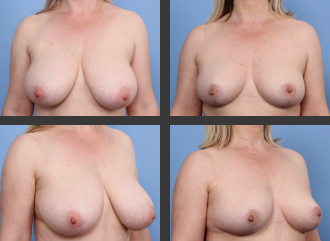Women may wish to reduce the size of their breasts for aesthetic or health reasons. Undergoing breast reduction surgery will instantly allow you more freedom in your clothes, alleviate pain, as well as make exercise and activities easier.
What is Breast Reduction?
Breast reduction surgery, also known as mammoplasty, is a commonly performed breast surgery. It will reduce the size of your breasts while at the same time lifting and improving their shape. A mammoplasty removes excess breast tissue and skin and repositions the nipple to the middle of the breast. It then elevates and reshapes the breast tissue before fixing it in its new position on the chest wall. Your breast surgeon will work to achieve a breast size and shape that is in better proportion to your body. This will help reduce pain, improve posture, and increase your overall comfort.
Breast Reduction with Dr Broadhurst
“I pride myself on the individual care and support I provide each of my patients. From your first consultation, I will work one-on-one with you to tailor a treatment plan to suit your body.”

Consultation
Your Initial Consultation
Your initial consultation with Dr Andrew Broadhurst will be virtual via FaceTime. Dr Broadhurst will ask you questions about your medical history and discuss any pregnancy plans. Due to the personal nature of this process, we will also need to discuss your breast concerns and what you hope to achieve. This will help your breast surgeon develop a treatment plan and outline what you can expect after your surgery.
Your Second Consultation
You will see Dr Broadhurst for a second consultation. This will be face to face at one of our Brisbane, Sunshine Coast, Hervey Bay, or Bundaberg locations. The discussion will ensure you have a complete understanding of the procedure and give you the opportunity to ask any further questions.
Dr Broadhurst welcomes any questions or concerns you have regarding your breast surgery. He is highly knowledgeable, and you can feel at peace knowing he’ll provide you with specialised care throughout the entire process.
Procedure
What to expect during your procedure?
A breast reduction surgery is performed as day surgery under general anaesthetic. The process takes roughly 1.5 to two hours, depending on the complexity of your surgery. Dr Broadhurst makes careful incisions and removes excess breast tissue and skin. He will then use the remaining breast tissue to reshape a more ideal breast shape and size.
The nipple will remain attached to your breast throughout surgery so as to not interfere with nipple sensation and the ability to breastfeed. However, patients who need a massive reduction may require a nipple-areolar graft. This is where the surgeon completely removes the nipple from the breast and surgically attaches it once the breast has been reduced. Your surgeon will then close your incisions and apply dressings. Some patients may have both internal dissolving sutures and skin staples.
Depending on the extent of your physical activity, you should fully recover within one to two weeks.
Incisions & Scarring
The location of your incisions will depend on the size and shape of your breasts, the amount of skin and tissue to be removed, and the advice of Dr Broadhurst. Scars may fade over time but will never completely disappear. Different incision methods may be used to reduce your breasts, including:
Lollipop Lift

The lollipop lift method, also known as “vertical breast reduction,” involves two incisions. The surgeon makes one incision around the areolar and one from the bottom of the areolar to the natural breast crease (infra-mammary fold). This type of incision is so named because it resembles a lollipop. The benefit of this technique is that scars are modest as well as easily hidden.
Anchor Lift

This method is the most common and involves three incisions. The first is around the areolar. The second runs vertically down from the lower edge of the areolar to the crease under the breast, and the third is made horizontally along the natural curve of the breast crease. This technique is ideal for women with significant drooping or sagging of the breasts.
Before & After
Whilst this breast reduction surgery has a high patient satisfaction rate, it may not be suited to everyone. Before deciding to undergo surgery, you should discuss your concerns with a qualified surgeon to ensure you are a good candidate. Additionally, you may be advised to follow instructions before your breast surgery to reduce risks and help your body prepare. For example, you may need to:
- Refrain from smoking
- Avoid taking aspirin and other blood-thinning medicines
- Not apply lotions or perfumes right before your surgery
- Follow instructions about when to stop eating and drinking
- Make sure you have someone to drive you home
- Understand the risks and benefits of your mammoplasty
After your breast reduction surgery, your breast area will need time to recover and settle into its new position. This means you will be able to fully enjoy your results a few weeks after surgery. Your breasts will then feel lighter, firmer, and smaller. The smaller size can have a number of benefits, including:
- Improved symmetry
- More even breast and nipple size
- A firmer and more raised breast appearance
- Improved posture
- Less shoulder, back, and neck pain
- Increased comfort when playing sports


